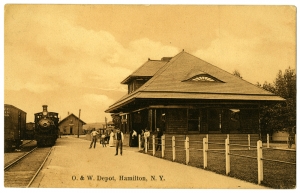1908. Named for Colgate’s first student, it was an informal organization open to all ministerial students and a few years it was to have its own house in the center of the village.
The rise of modern Colgate athletics may be said to date from the turn of the century. There had been a serious slump at the end of the ’90’s with teams often defeated as their followers “hunched”
in their seats to watch the scores mount. The football fortunes were especially low in 1899 when Colgate twice lost to Hamilton College, the big rival. For the second game, however, the students en masse escorted the team to Utica where the game was played, an unprecedented demonstration of support, and at no time did they cease to cheer them on. When the game was over they realized that they had cheered in defeat and had developed a new spirit which was to contribute to various measures for fostering the athletic program such as a new athletic tax, hiring of coaches in all sports, training tables, training rules, organized cheering with cheerleaders, and the granting of bloc “C’s”
to players. Additional impetus came from the completion of Whitnall Field with its fine new facilities for football, baseball, and track and the advent of “Doc”
Huntington whose guidance and encouragement were vital.
By 1902 an upswing in football was clear and for it particular credit goes to the coach, Frank J. (“Buck”
) O’Neill, Williams, ’02, who had been both captain and coach his senior year. His effective instruction, severe discipline, good judgement of potential football prowess among the students, and the courage and assurance he gave the team produced miracles. They won five games, lost three, and tied Hamilton College.
Football relations with Hamilton took a new turn in 1903 when Colgate began a steady winning streak which led to termination of the series in 1907. By this time the growing enrollment in the College had provided sufficient talent and it had been so well developed that the teams of the two institutions were no longer on a par. Meanwhile the rivalry with Syracuse, which had been resumed in 1902 through O’Neill’s intervention, supplanted that with the college in Clinton in intensity and interest.
O’Neill, who had been recalled to Williams in 1903 to rescue his Alma Mater from misfortune on the gridiron, returned for the 1904 and 1905 seasons. It was in the former that his players, Walter Runge,’06,





